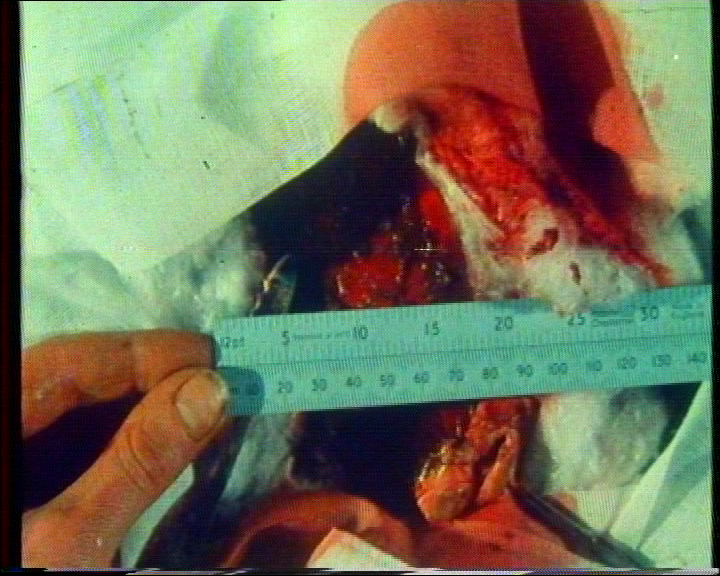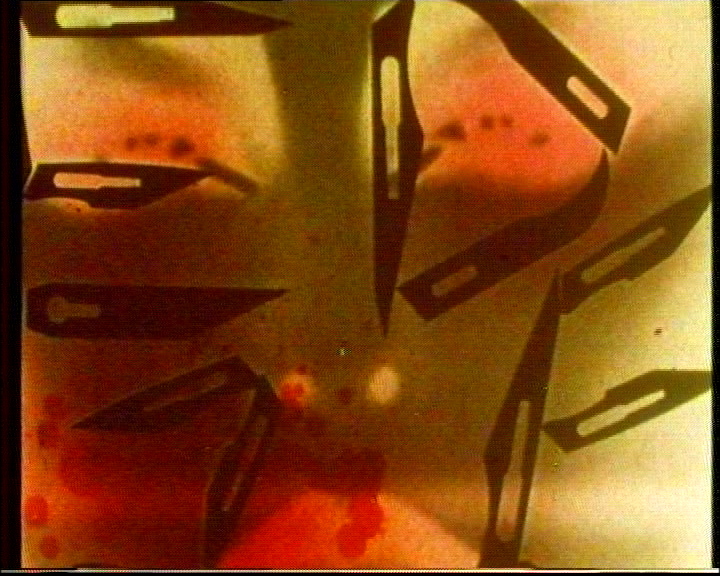While Sandra Lahire (1950-2001) is best known for her live action films, prior to 1986 she was working primarily with animation. These early works have received little attention, possibly because of their experimental approach and difficult subject matter. Throughout her oeuvre Lahire dealt with the impact of technology, ideology, science and medicine on the body. Despite these being tough issues Lahire explores them with humour: ‘There has to be an element of fun with something raw and close to the bone or you don’t come across to other people’ (Lahire in Buxton, 1996: 14).
In her animated works, rather than pointing the camera out at the world, she focused it toward a rostrum table and created the body upon it. Arrows (1984) and Edge (1986) both employ multiple methods to create their urgent and impassioned messages concerning the vulnerabilities, resilience and interconnectedness of embodied beings.
As though the rostrum table itself were a body, Lahire layered upon it materials that are associated with the physical. These include cut up photographs of bodies and crude mask like drawings of bruised human faces animated with real objects such as plastic tubing, medical instruments, bandages, surgical gloves, bloody swabs, fur, claws and stand-ins for bodily parts and fluids, such as a red capsicum and flowers (see figures 1 and 2).
Making the process transparent, Lahire’s hands are constantly visible animating these materials, delving into and prizing apart the layers and then bandaging and stitching them back together, as though the caressing gestures might repair at the level of film the damage done in reality. The diverse methods, dense visuals and frenetic pace are grounded by the constancy of Sylvia Plath reciting her poems The Thin People (1957) and Poem For A Birthday – The Stones (1962).
Edge compares the horrors of vivisection to that of cosmetic surgery. Images of restrained monkeys and cats with screaming mouths, wounds and implants are rapidly smothered over. The butchery that the low resolution animal campaigning photos common to that period can’t clearly depict Lahire reconstructs through compositions of bloody gauzes, spilt entrails, shots of her own eyes and mouth wide open as in terror and claw like scratches dragged directly onto film. Throughout, an equation is made between animal bodies and that of the artist as Lahire films her own gaze confronting the viewer edited together with the chemically destroyed eyes of rabbits. Lahire alleviates these scenes of distress with ironical commentary at both vocal and visual levels and animation is one tool through which it is possible to bring about such lightness: it is humorous to watch slices of salami, compared to the surgical removal of human fat, jerking themselves around the frame, while a group of back-lit razor blades appears without malice, like the geometric shapes of early abstract animation (see figure 3).
Arrows narrows the focus of concern with the suffering body to that of the human condition of anorexia. Imagery of grids, caged birds, spiky red shards, snakes and body parts cut from magazines are moved through limited animation, twisted about on the rostrum table to the soundtrack of exercise class instructions. The isolation experienced by those with anorexia is conveyed through the soundtrack as Lahire’s requests for counsel are met with an answer phone. Throughout, Lahire adopts different positions and roles: from that of the media analyst, the scientist, the anguished and skeptical artist to the mimicry of non-humans. In photos she appears wing-like with a shawl draped upon her outstretched arms, suggesting that through weightlessness she will become airborne (see figure 4). Shots of a rotating owl head are matched with photos of Lahire as she describes circular swiveling movements, while ‘her hands replicate the movement of wings’ (Buxton, 1996: 12). It is as though, in her identification with beings that are trapped in violent systems, the artist is continuously searching for affinities between her own body and that of non-humans.
Rosi Braidotti finds that idealist philosophy positioning of thought as other and higher than matter has meant that animals, relegated to the latter category, are devalued. She proposes a post-human position to be one of a widened subjectivity that rejects anthropocentrism or the limiting of the roles of animals in favor of that which she describes as an assemblage of human-animal interaction (Braidotti, 2013: 81-82). Through devices of animation, montage editing, superimposition and mimicry Lahire sets up an equivalence and an inseparability not only between her own and animal bodies, but also between objects and materials. In this sense she anticipates the recent explosion of post-humanist ecologically oriented art practice (Marcus Coates and Jacqueline Traide) and also the screen based eco-aesthetics of the present day (see for example Pick & Panse, 2013).
References
Braidotti, Rosi (2013), The Posthuman, Cambridge: Polity Press.
Buxton, Jo (1996), ‘Interview with Sandra Lahire: The Thin People’, in Harcombe, D. & Smith, V. (eds.) Boiling – Experimental Animation Journal, London: LFMC, pp. 12- 16.
Panse, Silke (2013), ‘Land as Protagonist. An Interview with James Benning’, in Pick, A. and Narraway (eds.), Screening Nature: Cinema Beyond the Human, Oxford/New York: Berghahn Books.
Vicky Smith has been making and writing about experimental animation since 1990. Recent international screenings include: Antimatter, Canada; SF Moma; Anthology NY; Tates’ Britain and Modern. Smith co-edited and published ‘boiling’: journal of experimental animation (1995) and is co-editing with Nicky Hamlyn Experimental & Expanded Animation: Current Perspectives and Practices, due early 2018.




